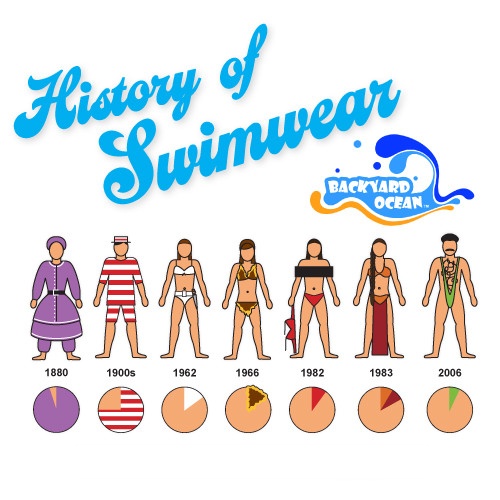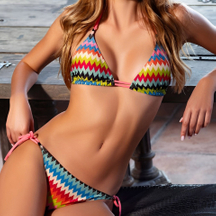Content Menu
● Introduction
● What Is Considered Swimwear?
>> Definition of Swimwear
>> Swimwear vs. Swimsuit
● The Evolution of Swimwear
>> A Brief History
● Types of Swimwear
>> 1. Swimsuits
>> 2. Swim Trunks
>> 3. Burkinis and Modest Swimwear
>> 4. Competitive Swimwear
>> For Women
>> For Men
● Cultural Significance of Swimwear
>> Unisex and Specialized Swimwear
● What Materials Are Used in Swimwear?
>> Common Swimwear Fabrics
>> Key Properties of Swimwear Fabrics
● The Function and Fashion of Swimwear
>> Purpose and Performance
>> Modesty and Cultural Considerations
● What is Considered Appropriate Swimwear?
>> 1. Public Pools and Beaches
>> 2. Private Pools
>> 3. Cultural Sensitivity
● How to Choose the Right Swimwear
>> Factors to Consider
>> Sizing Tips
● Swimwear Manufacturing and OEM Services
● Conclusion
● Frequently Asked Questions About Swimwear
>> 1. What is considered swimwear?
>> 2. What materials are best for swimwear?
>> 3. How do I choose the right swimwear for my body type?
>> 4. What is the difference between a swimsuit and swimwear?
>> 5. Can swimwear be used for activities other than swimming?
● Citations:
Introduction
Swimwear is an essential part of modern life, serving not only as functional attire for swimming and water sports but also as a fashion statement and a reflection of cultural trends. But what is considered swimwear? This comprehensive guide explores the definition, history, types, materials, and cultural significance of swimwear, providing a thorough understanding for consumers, brands, and manufacturers alike. Whether you are a swimwear enthusiast, a brand owner, or simply curious, this article will answer all your questions about what is considered swimwear.

What Is Considered Swimwear?
Definition of Swimwear
Swimwear refers to clothing specifically designed to be worn while swimming, diving, or participating in other water-based activities. It is typically made from lightweight, quick-drying materials such as nylon, spandex, or polyester, and is engineered for comfort, durability, and performance in aquatic environments[2][3][4]. Swimwear is an umbrella term that includes a wide variety of garments, from one-piece swimsuits and bikinis to board shorts, rash guards, and wetsuits[5][2][6].
> "Swimwear can include several types of garments, including swimsuits, swim trunks, rash guards, and more. For example, a two-piece swimsuit is considered swimwear, and a rash guard is also considered swimwear."[5]
Swimwear vs. Swimsuit
While the terms "swimwear" and "swimsuit" are often used interchangeably, there is a subtle distinction. A swimsuit generally refers to a tight-fitting garment designed for swimming, such as a one-piece or bikini. Swimwear, on the other hand, is a broader category encompassing all clothing suitable for water activities, including cover-ups, rash guards, and swim shorts[5][2].
The Evolution of Swimwear
A Brief History
Swimwear has evolved dramatically over the centuries, reflecting societal attitudes toward modesty, fashion, and functionality. Early swimwear was often cumbersome and covered most of the body. The 20th century saw the rise of more form-fitting and revealing styles, influenced by changing norms and the growth of beach culture[6].
- Early 1900s: Full-body suits made from wool or cotton.
- 1940s-1950s: Introduction of the bikini and more fitted one-piece suits.
- 1960s-1980s: Bold prints, new fabrics, and the rise of competitive swimwear.
- Modern Era: Diverse styles, high-performance materials, and a focus on both fashion and function.

Types of Swimwear
Swimwear can be categorized into several types, each serving different purposes and preferences. Here are the most common types:
1. Swimsuits
Swimsuits are the most recognized form of swimwear. They come in various styles, including:
- One-Piece Swimsuits: These are a single garment that covers the torso and are popular among women for their modesty and comfort.
- Two-Piece Swimsuits: Often referred to as bikinis, these consist of a top and bottom and are favored for their variety of styles and designs.
- Rash Guards: These are tight-fitting shirts made from spandex or nylon, designed to protect the skin from sun exposure and abrasions while surfing or swimming.

2. Swim Trunks
Swim trunks are typically worn by men and are designed for comfort and mobility. They come in various lengths and styles, including board shorts, which are longer and often used for surfing.
3. Burkinis and Modest Swimwear
In recent years, there has been a rise in demand for modest swimwear options, such as burkinis, which cover the body while allowing for swimming. These garments are designed to meet cultural and religious standards of modesty.
4. Competitive Swimwear
Competitive swimwear is specifically designed for athletes participating in swimming competitions. These suits are made from high-tech materials that reduce drag and enhance performance in the water.
For Women
| Type | Description |
| One-Piece Swimsuit | Classic, full-body coverage, available in athletic and fashion-forward designs[4]. |
| Bikini | Two-piece with separate top and bottom, highly customizable in style and fit[4][6]. |
| Tankini | Two-piece with a tank-style top and bikini bottom, offering more coverage[4]. |
| Monokini | A one-piece with cutouts, blending bikini and one-piece aesthetics[6]. |
| Swim Dress/Skirt | Swimsuit with an attached skirt for extra coverage and a feminine look[4]. |
| Burqini | Full-body swimwear designed for modesty, often worn for religious or health reasons[6]. |
| Rash Guard | Athletic shirt made of spandex/nylon/polyester, protects from sun and abrasion[6][5]. |
For Men
| Type | Description |
| Swim Trunks | Loose, mid-thigh shorts made of quick-drying fabric, popular for recreational swimming[6]. |
| Board Shorts | Longer, non-elastic shorts designed for surfing and board sports[6]. |
| Swim Briefs | Tight-fitting, brief-style swimwear, often used in competition (e.g., "Speedos")[6]. |
| Jammers | Knee-length, tight-fitting suits for competitive swimming[6]. |
| Square Cut Trunks | Similar to briefs but with a boxier shape[6]. |
| Rash Guard | As above, used for sun protection and water sports[6]. |
| Wetsuit/Drysuit | Insulated suits for cold water or diving activities[6]. |
Cultural Significance of Swimwear
Swimwear varies significantly across cultures, reflecting local customs, traditions, and attitudes towards modesty. In some cultures, swimwear is designed to be more revealing, while in others, it is more conservative. Understanding these cultural differences is essential for respecting local norms when traveling.
Unisex and Specialized Swimwear
- Wetsuits/Drysuits: Provide thermal insulation for diving, surfing, and cold water activities[6].
- Drag Suits: Baggy suits worn over regular swimwear for training resistance[6].
- Racing Suits: High-tech suits designed for competitive swimming to reduce drag[6].
What Materials Are Used in Swimwear?
Common Swimwear Fabrics
The choice of material is crucial for swimwear, impacting comfort, durability, and performance[7][4].
- Polyester: Highly durable, chlorine-resistant, retains color, and holds its shape. A leading choice for competitive and frequent swimmers[7][4].
- Nylon (Polyamide): Lightweight, smooth, and stretchy, but less chlorine-resistant than polyester[7][4].
- Spandex (Lycra/Elastane): Provides excellent stretch and a snug fit, often blended with other fibers[7][4].
- PBT (Polybutylene Terephthalate): A type of polyester with natural stretch, lightweight, and fast-drying[7].
- Recycled Fabrics: Increasingly popular for eco-friendly swimwear, offering similar performance to traditional materials[4].
Key Properties of Swimwear Fabrics
- Quick-drying
- UV protection
- Chlorine resistance
- Shape retention
- Comfort and breathability[7][4]

The Function and Fashion of Swimwear
Purpose and Performance
Swimwear is designed not only for swimming but also for sunbathing, water sports, and even as a fashion statement[2][6][4]. The specific requirements depend on the intended use:
- Recreational Swimming: Comfort, fit, and style are priorities.
- Competitive Swimming: Streamlined fit, low drag, and durability.
- Water Sports: Additional features like UV protection, abrasion resistance, and secure fit (e.g., rash guards, wetsuits)[5][6].
- Sunbathing and Fashion: Trendy designs, vibrant colors, and unique cuts.
Modesty and Cultural Considerations
Swimwear styles vary globally, influenced by cultural norms and personal preferences. Some cultures favor modest full-body swimwear (e.g., burqinis), while others embrace more revealing styles[6].
What is Considered Appropriate Swimwear?
The definition of appropriate swimwear can vary based on location, activity, and cultural context. Here are some general guidelines:
1. Public Pools and Beaches
Most public pools and beaches require swimwear that is specifically designed for swimming. This typically excludes clothing made from cotton or other heavy materials that can become waterlogged. Acceptable swimwear includes:
- Swimsuits (one-piece or two-piece)
- Swim trunks
- Rash guards
2. Private Pools
Private pools may have more relaxed rules regarding swimwear. However, it is still advisable to wear appropriate swimwear to ensure comfort and safety.
3. Cultural Sensitivity
When traveling to different countries, it is crucial to be aware of local customs regarding swimwear. In some places, wearing revealing swimwear may be frowned upon, while in others, it may be perfectly acceptable.
How to Choose the Right Swimwear
Factors to Consider
- Body Type: Different styles flatter different shapes. For example, high-waisted bottoms for tummy coverage or structured tops for bust support[12][4].
- Intended Use: Competition, recreation, sunbathing, or water sports[12].
- Material: Choose chlorine-resistant fabrics for pools, or UV-protective fabrics for outdoor use[7][4].
- Fit and Comfort: Ensure a snug but comfortable fit to avoid wardrobe malfunctions or discomfort[12][4].
Sizing Tips
- Measure bust, waist, and hips accurately.
- Consult brand-specific size charts.
- Consider fabric stretch and personal preference for coverage[4].
Swimwear Manufacturing and OEM Services
For brands, wholesalers, and designers, understanding what is considered swimwear is crucial for product development and sourcing. As a leading swimwear OEM manufacturer in China, we offer custom design, high-quality production, and flexible order quantities to help you build your swimwear brand[13].
Conclusion
In summary, swimwear encompasses a wide range of garments designed for water activities. From swimsuits to swim trunks and modest swimwear, the options are diverse and cater to various preferences and cultural norms. Understanding what is considered swimwear and the materials used can help individuals make informed choices when selecting their swim attire.
Frequently Asked Questions About Swimwear
1. What is considered swimwear?
Swimwear includes any clothing designed for swimming or water-based activities, such as swimsuits, bikinis, board shorts, rash guards, and wetsuits[5][2][6].
2. What materials are best for swimwear?
Polyester, nylon, spandex, and PBT are popular for their durability, stretch, and quick-drying properties[7][4].
3. How do I choose the right swimwear for my body type?
Consider styles that flatter your shape, such as high-waisted bottoms for tummy control or structured tops for bust support[12][4].
4. What is the difference between a swimsuit and swimwear?
A swimsuit is a specific garment for swimming, while swimwear is a broader category that includes all types of clothing suitable for water activities[5].
5. Can swimwear be used for activities other than swimming?
Yes, swimwear is also worn for sunbathing, water sports, beauty pageants, and as fashion attire[2][6].
Citations:
[1] https://www.istockphoto.com/photos/swimwear
[2] https://www.definitions.net/definition/swimwear
[3] https://dictionary.langeek.co/en/word/182235
[4] https://jantzen.com/blogs/jantzen-news/swimwear-q-a-everything-you-need-to-know
[5] https://hapari.com/blogs/lifestyle/swimsuit-vs-swimwear-what-s-the-difference
[6] https://en.wikipedia.org/wiki/Swimsuit
[7] https://www.kiefer.com/blog/post/choosing-swimsuit-fabric-best-swimwear-material.html
[8] https://www.gettyimages.com/photos/swimwear
[9] https://www.youtube.com/watch?v=rvtxuWVF6Yc
[10] https://www.dailymotion.com/video/x8lgbrb
[11] https://pixabay.com/videos/search/women's%20swimwear/
[12] https://www.swimwearshack.com.au/swimwear-frequently-asked-questions?srsltid=AfmBOoqD3gF5pwLzGTOHC1D4HAeEumLfsgidK76s0xrdZptyTn5rCSiR
[13] https://swimwearbali.com/10-common-questions-about-swimwear-manufacturing
[14] https://www.freeimages.com/search/swimwear
[15] https://www.4seasons-club.com/wp-content/uploads/2017/08/Appropriate-Swimwear-flier.pdf
[16] https://knix.com/blogs/resources/swimwear-vs-beachwear-what-s-the-difference
[17] https://www.portland.gov/parks/recreation/examples-approved-swimwear
[18] https://stock.adobe.com/search?k=swimsuit
[19] https://www.reddit.com/r/EnglishLearning/comments/1h8rmax/what_do_you_call_this_a_swimsuit_a_bathing_suit_a/
[20] https://www.macys.com/ce/swimwear-guide/womens-swimsuit-and-bikini-styles
[21] https://www.aguabyaguabendita.com/collections/swimwear
[22] https://www.bustle.com/articles/156006-17-unique-swimsuit-styles-you-need-to-know-about-photos
[23] https://create.vista.com/photos/swimsuits/
[24] https://www.reddit.com/r/Swimming/comments/1krqhrf/question_with_swimwear/
[25] https://brazilian-bikinis.net/frequently-asked-questions/
[26] https://swimsuitsjustforus.com/pages/faqs
[27] https://chatelaine.com/style/fashion/how-to-buy-a-swimsuit-online-faq/
[28] https://www.swimoutlet.com/blogs/guides/understanding-womens-swimwear?srsltid=AfmBOopqCTLNtFzGABvL7_f4H8iiLJznhfXcVSSD2CbOPO-K6yWtQKsC
[29] https://houseofcoco.net/a-beginners-guide-to-buying-swimwear-rules-mistakes-and-more/
[30] https://wellsbranch.swimtopia.com/swimsuit-requirements-faq



































































